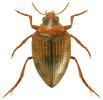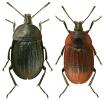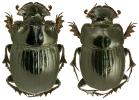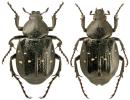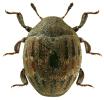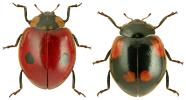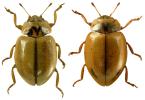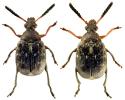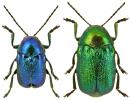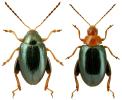The most recent checklist of beetles of the British Isles includes 4072 species in 103 families, listed in taxonomic order below. Click on the links to obtain more information about each family, including identification guides, websites and (where appropriate) recording schemes. This guide has been prepared by Mark Gurney. A pdf version is available here.
I find the easiest way to identify a beetle is to look through a reference collection of well-carded specimens. You need a museum for this, which is not always convenient. As a substitute, here is a collection of photographs of specimens from Lech Borowiec's website. A few families are represented by photos from Udo Schmidt. Thanks to both of them for permission to use their photos here, and for making these resources available to everyone on their websites.
Size and shape are important things to look for when trying to match beetles to families. Is the body rounded or rather straightsided? Is it wide or narrow, tapering or widest towards the rear? Do the wing-cases cover the whole abdomen or are there some segments exposed? How long are the antennae relative to the body and the palps? Note also whether the antennae are clubbed, and whether any of the tarsal segments are lobed (in families with lobed tarsal segments, often only one segment is lobed).
How to use this guide:
The number in front of the family name is the number of species in that family. The family name is followed by the size range of species in the family, and then by the number of segments in the tarsi (front-middle-hind), stating 'Lobed' if some of the tarsal segments are lobed. The number and shape of tarsal segments is used in most keys, but on small beetles they are not easy to see. One of the segments is often much smaller and hidden among the others, and this is not counted in the number given. Do not worry if you are not sure how many segments there are: you can identify most beetles without needing to count their tarsal segments.
Not all the species in each family are shown, but I have included what I hope is a broad enough range to illustrate the variety of shapes and colours within the family. If you find a match for your specimen, do still carry on the end of the guide to make sure that there is nothing else that is an even better match later on. It is quite likely that your specimen will not match any one of the species illustrated here. In that case, you might at least find that it looks more like some families than others, and that will give you a starting point when you look elsewhere. You can also use the illustrations as a check if you are using a key: if you cannot decide which way to go at a couplet, have a look at the families that either side leads you to and you might find it obvious that your beetle does or does not belong to one side or another.
This guide is just another source to help you name a beetle. It will not always work. Neither will any of the other guides and keys out there, so use as many different sources as you can find, and be prepared to let some things remain as mysteries until you have more experience.
If you are just starting out, you might make mistakes or think that your beetle seems not to belong to any family. This is frustrating. But the only difference between you and an expert is experience. If you build up a collection, it will not take long before you can recognise groups of species at a glance and you get a feel for where a beetle might belong. Just as important, you will soon know when something does not fit and you need to look elsewhere. None of this is much comfort when you are stuck with a seemingly unidentifiable insect, but remember that things do get easier.
Photos © Lech Borowiec. Used here with permission. Larger versions are on his website. Photos of the Limnichidae, Ptilodactylidae, Drilidae, Bothrideridae, and Raymondionymidae by Udo Schmidt available under a creative commons Creative Commons Attribution-ShareAlike 2.0 Generic licence.



